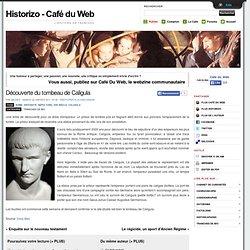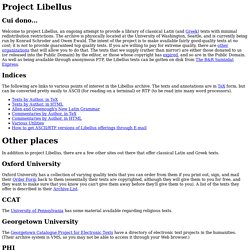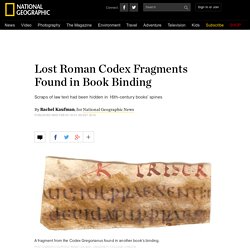

Noctes Gallicanae index général. Découverte du tombeau de Caligula. Une drôle de découverte pour ce drôle d'empereur: un pilleur de tombes pris en flagrant délit donne aux policiers l'emplacement de la tombe.

Le pilleur essayait de revendre une statue provenant du site, lors de son arrestation. Il aura fallu pratiquement 2000 ans pour découvrir le lieu de sépulture d'un des empereurs les plus connus de la Rome antique. Caligula, empereur fou ou tyran provocateur, a laissé une trace indélébile dans l'Histoire européenne. Dépravé, sadique et criminel, il fut assassiné par sa garde personnelle à l'âge de 28ans en 41 de notre ère. Les motifs du crime sont obscurs et se mélent à la réalité: complot des sénateurs, révolte des soldats après qu'ils aient appris qu'il souhaitait nommer son cheval Consul... Hors légende, il reste peu de traces de Caligula. La statue prise par le pilleur représente l'empereur portant une paire de caligae (bottes). Les fouilles ont commencé cette semaine et devraient confirmer si le site étudié est bien le tombeau de Caligula.
Rome Reborn. Images - Rome Reborn 2.2 - City Views An aerial view of the city center seen from the east.

Visible are the Tiber River, Circus Maximus, Palatine, and Colosseum. Medium Resolution. Ostia - full-text books and articles. Histoire critique du christianisme romain. Marcus Aurelius (A.D. 161-180) Rome Antique. Roman Emperors - DIR Marcus Aurelius. SAMNITES AND SAMNIUM - History and Archaeology. Caracalla. Caracalla, Museo della Civilta, Rome Caracalla was born on 4 April AD 188 in Lugdunum (Lyons), being named Lucius Septimius Bassianus. His last name was given him in honour of the father of his mother Julia Domna, Julius Bassianus, high priest of the sun god El-Gabal at Emesa. The nickname Caracalla was given to him, as he tended to wear a long Gallic cloak of that name.
In AD 195, his father, emperor Septimius Severus, declared him Caesar (junior emperor), changing his name to Marcus Aurelius Antoninus. This announcement should spark off a bloody conflict between Severus and Clodius Albinus, the man who had been named Caesar previously. In AD 208 Caracalla and Geta left for Britain with their father, to campaign in Caledonia. However, a blow was dealt to Caracalla's aspirations when in AD 209 Severus did also raise Geta to the rank of Augustus.
With the Caledonian campaign at an end the two then headed back for Rome with the ashes of their father. The scheme might have worked. Capitolium.org - Fori imperiali Roma - Imperial Forums - Officia. THE CHRISTIAN CATACOMBS OF ROME. La salle à manger rotative de Néron - Archéologie : sci-tech, sc. Consuls of the Roman Republic. Below is a list of the consuls of the Roman Republic from its foundation until the battle of Actium in 31 B.C.

There were normally two consuls elected for each year. If during that year a consul resigned from office or died, a "suffect" (replacement) consul was elected in his place. During various years of the first two centuries of the Republic, colleges (boards) of varying numbers of "military tribunes with consular power" were elected in place of consuls. The tradition also records (falsely--see below) four years when only dictators were chosen in place of consuls and another five years when no magistrates at all are preserved ("anarchy"). The list normally gives the "ordinary" (regular) two consuls, and any other magistrates are clearly indicated as such. In the first column appears the date B.C. as calculated according to the "Varronian" list of consuls. The system presented here is the so-called Varronian system worked out in the late first century B.C.
Droit Romain - EAO. The Roman Law Library ( Last Update : January 22, 2010 ) Project Libellus. Cui dono...

Welcome to project Libellus, an ongoing attempt to provide a library of classical Latin (and Greek) texts with minimal redistribution restrictions. The archive is physically located at the University of Washington, Seattle, and is currently being run by Konrad Schroder and Owen Ewald. The intent of the project is to make available fairly good-quality texts at no cost; it is not to provide guaranteed top quality texts.
If you are willing to pay for extreme quality, there are other organizations that will allow you to do that. The texts that we supply (rather than mirror) are either those donated to us (or released into the Public Domain) by the editor, or those whose copyright has expired, and so are in the Public Domain. Indices The following are links to various points of interest in the Libellus archive. Oxford University The University of Pennsylvania has some material available regarding religious texts. Georgetown University. Nova Roma. J. POUCET : Georges Dumézil et les historiens de la Rome ancienn. Plan de Rome.
McMicken College. Caligula. VITRUVE ET SES DIX LIVRES. Forum historiae iuris - Erste Europäische Internetzeitschrift fü. Ostia - Harbour City of Ancient Rome. De Imperatoribus Romanis Roman History Rom. Présentation du monument - ara pacis. Lost Roman Codex Fragments Found in Book Binding. Fragments of a lost ancient Roman law text have been rediscovered in the scrap paper used to bind other books.

The Codex Gregorianus, or Gregorian Code, was compiled by an otherwise unknown man named Gregorius at the end of the third century A.D.